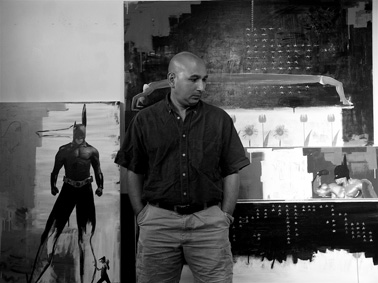Home

For over 20 years, Khaled Hafez has explored the continuous reproduction of dichotomies within and between the popular culture of his native Egypt, of France where he lived for several years, and of the United States – the ultimate consumer society and locus of political power, which seems to thrive on the marketing potential of divisive binaries. Through painting and video, Hafez has concentrated primarily on the construction of certain categories and the overlaps between them: East/West, sacred/commercial, old/new, good/evil, animal/human, male/female, and static/kinetic. His work shows how these dichotomies rest on the international system of commodities that creates both the ideas of (cultural) similarity and difference, as well as affective attachments to certain histories and identities. Hafez explores out how each half of a dichotomy has come to be signified through particular visual forms, figures, or objects. This work suggests that it is the continual replication of these visual signifiers in mass media that creates emotions of love and hate, notions of collective memory, and visions of the future. Dichotomies are attractive, then, because they have become seductive visual commodities.
Jessica Winegar, Ph.D.,
Assistant Professor
Department of Anthropology
Temple University
Philadelphia, PA
“In his paintings Egyptian artist Khaled Hafez pastes contemporary commercial imagery on a painterly stage to heighten the quarrel of abstraction versus figuration. This fight continues to be a deeply problematic topic within Islam, where imagery is largely prohibited in the visual arts. Hafez uses figures such as Batman or Catwoman to evoke the ancient gods of Egypt and Greece, demonstrating the persistence of certain cultural archetypes through today. Specifically, Hafez ruminates on the position of painting within Pharonic culture–with its serial imagery, “superhero” figures and clear moral narratives–as a precursor to today’s comics. Ancient Egyptian hieroglyphs were “film strips” reporting the tales of the nation’s aristocracy. Similarly, today’s commercials (of bathing beauties and muscle men) are our version of the healthy rulers of tomorrow.”
Marilu Knode
Assistant Director
Head of Research
Future Art Research,
Arizona State University